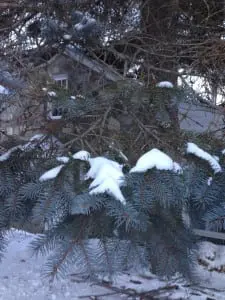By Pamela Doan
A reader asked: “I have Scotch pines lining my driveway and they’re overgrown. When can I prune them? Also, some of them seem to be dying. I know that Scotch pines aren’t long-lived; maybe they’re just at the end of their time. Is that possible?”
Pesky trees — they just grow and grow, and suddenly, the car gets lost in a forest on the way down the driveway. Maybe you could try a smaller car, instead? A Mini Cooper might be better, and imagine the mileage you’ll get.
It sounds like some cutting is more your style, though. Pruning successfully needs to take into account the type of tree and the outcome desired. Your question is very specific, so that helps. Timing is determined by both of those things.
Pines are conifers, evergreens with needles. Other evergreen types are called narrow-leaf, like yews and arborvitae, and then there are broadleaf evergreens including rhododendron and mountain laurel. Each needs a different approach, so looking into evergreens as a broad category could give you bad information.

Conifers have whorled branches with a circular formation around the section where growth occurs in the tip. These branches usually have one push of new growth annually, and the number of buds that appear will determine how much it will grow.
There is an active and inactive part of the whorled branch. Starting from the end of the branch and moving in toward the trunk, the active part has buds and needles and then there is a section where the needles end. That is the inactive section. Don’t cut the inactive part of the branch. It won’t grow back and you’ll be left with bare branches.
Pruning cuts should not be made flush to the trunk, either. This will damage the branch collar and lead to decay. Make a cut that’s several inches from the branch collar, the ridge of bark where the branch connects to the trunk, and at a 45-degree angle from the bark ridge, noticeable for its rough bark near the crotch of the branch.
Now back to timing. Pinching back the candles or tips during its growth spurt in late spring will help keep its size down. Do this by hand, not with tools. Just break off about half the length of the new growth. Once the growth for the year is complete, probably near the end of May, the Scots pine can be pruned with hand trimmers. Never use hedge trimmers. These will tear up the bark.
June and July are your best months for a heavy pruning to shape them to your space. It will give your trees plenty of time to recover before cold weather sets in. Pruning too late leaves open cuts that are more susceptible to disease.
Without more information, I can’t help identify what might be happening to the trees you describe as dying. There are weevils and sawflies that damage trees and also diseases that can kill them. Examine the trees for signs of decay, needle loss and bark damage. These will indicate what kind of issue the tree is dealing with and whether a pest or disease causes it. Needles look healthy if they are entirely green to the tip. Consult an arborist for help.
Putting the right plant in the right place will save a lot of work. In this case, it sounds like your trees are going to require annual pruning and maintenance to keep your driveway accessible. If a subcompact car or moving the driveway isn’t in the plans, you might want to consider repurposing some of these as Christmas trees; they’re commonly grown and harvested for holiday lots.
You’ll always have to prune both sides of the tree, not just the branches on the driveway, to keep it in balance and to avoid having an awkward shape. Scots pines can grow to be 70 feet tall and 30 feet wide. That’s potentially a lot of pruning.
There are ornamental evergreens that could be better suited to this part of your yard. There are native holly and juniper varieties that are smaller and more manageable in a tight space. Wildflower.org is a website of native plants run by the Lady Bird Johnson Wildlife Center, and it’s easy to search for possibilities there if that’s something you want to consider. Good luck bringing your landscape in line with your motoring needs.

